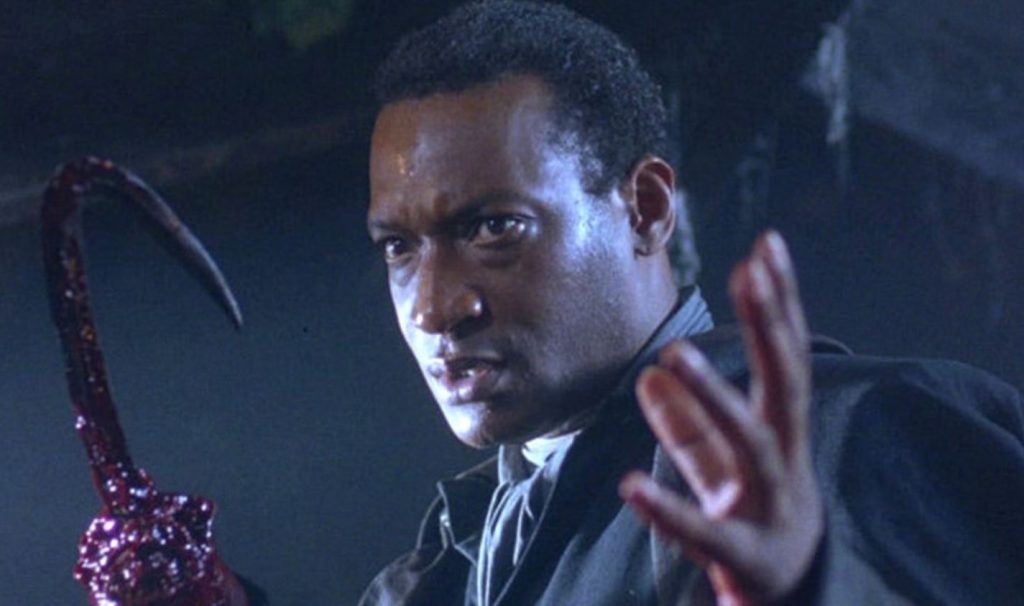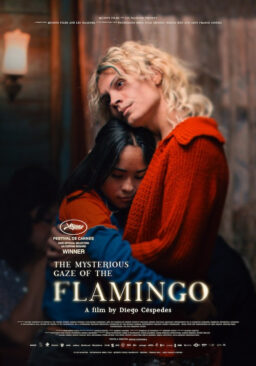I enjoy when horror films do more than just throw sudden shocks and jolts at audiences. Bernard Rose’s 1992 film “Candyman” is one example. While it surely shocks us with a series of horrific bloody moments during its second half as required, the movie first engages us with mood and ideas before throwing us fully into its insidious terror and dread.
The movie begins with one interesting horror story idea about urban legends. As many of you know, urban legends are the reflections of our collective fear of anonymously living alone in big cities, and the movie puts a curious spin on it. What if an urban legend is actually real? What if it’s real because it’s believed to exist, rather than the other way around? And what if it’s actually powered by the collective belief behind it? If such a thing is possible, then what can be said of those many different religious or supernatural entities believed by millions of people out there? The movie deals with its ideas in unexpectedly intelligent ways, and then it eventually leaves us something to muse on for a while after the end credits.
For me, it is always nice to see horror movie characters who are smart and reasonable, and the two main characters of “Candyman,” Helen (Virginia Madsen) and Bernadette (Kasi Lemmons), are such ones. They are graduate students who have been researching for their doctoral thesis at the University of Illinois, Chicago, and their research subject is, yes, urban legends. When we are introduced to Helen at the beginning of the film, she is listening to a young female student who tells her a scary tale about a supernatural entity called Candyman. Helen is only mildly interested because this is just one of many Candyman stories she and Bernadette have collected during their ongoing research.
According to those Candyman tales, he will come to whoever dares to summon him by saying his names five times while looking into mirror and then will leave a bloody carnage behind him. As your reasonable intellectuals, Helen and Bernadette do not seriously believe what they hear from their interviews. In fact, they even attempt to call for Candyman in front of a mirror just for little amusement, though Bernadette steps back when she is about to call him five times along with Helen.
In the meantime, Helen happens to learn from one of the janitors working in the university that Candyman is believed to exist by the residents of the Cabrini-Green Housing complex in the Near North Side area of Chicago. They really believe Candyman is living somewhere in the complex, and they also believe that he is responsible for many horrible incidents in their neighborhood – including one ghastly murder case widely reported by the local media not so long ago. As delving more into the dark past of Cabrini-Green, Helen becomes more curious, and then she decides to go there along with Bernadette for collecting any good materials worthy of their thesis, though Bernadette is quite concerned about their safety when they arrive there.
Bernadette’s concern is well-justified. Now its area is changed a lot at present (I was disappointed when I happened to pass by the area in the middle of my Chicago trip during April 2010), but, the Cabrini-Green Housing Complex, whose population mainly consisted of low-income African American people, was one of the most criminally notorious housing complexes in USA. The movie gives us some vivid glimpses of this dangerous neighborhood in the early 1990s. While gang members often hang around the front entrances of those shabby apartment buildings, there are dark, dirty, and deserted places you do not dare to enter, and the mood becomes all the more unnerving as Helen and Bernadette go inside these places just for their academic interest and benefit.
And we also get some background knowledge on Candyman when Helen later happens to have a dinner with her professor husband and his colleagues, one of whom turns to be very knowledgeable about Candyman and how his legend has been connected with Cabrini-Green. According to the legend, Candyman was a tragic victim of racism in the late 19th century America, and Cabrini-Green is known as the spot where the remains of his body were buried after he was savagely tortured and killed by goons hired by the enraged father of a Caucasian lass with whom he happened to fall in love.
Rose, a British filmmaker who has mainly been known for “Paperhouse” (1988) and “Immortal Beloved” (1994), gradually dials up the level of spookiness on the screen. Frequent overhead shots throughout the film bring an ominous tone to the story along with Phillip Glass’ eerie score, and it sometimes feels like Candyman watching over Helen’s ongoing investigation from somewhere above. Despair and terror are palpably felt everywhere in the Cabrini-Green scenes in the film, and, like Helen, we can clearly sense that this real-life neighborhood is as horrible as the Candyman legend. This is a harsh world where terrible incidents happen everyday and then are neglected by people outside including the police, and those poor people living there may just choose to believe that a boogeyman whom no one can stop is responsible for all these atrocious happenings in their crime-ridden neighborhood.
So, is it just a mere urban legend born out of their painfully real horror and despair? Helen seems to think so especially after finding the possible answer to the aforementioned murder case, but, unfortunately for her, the movie is loosely based on executive producer Clive Barker’s short story The Forbidden. Like his famous first movie “Hellraiser” (1987), many of Barker’s novels and short stories are gruesome tales of flesh and blood accompanied with supernatural elements, and “Candyman” is no exception. As the story enters its second half, Candyman turns out to be real indeed, and the truth behind him is not only fascinating but also quite horrifying. It seems that Helen’s research makes Candyman piqued a lot more than casually calling his names five times in the mirror – and now he is ready to coerce and seduce her into embracing his darkness for prolonging his legend as well as his existence.
Consequently, Helen finds herself in a big serious trouble with the police as several shocking incidents keep happening around her. She comes to gather what is really going on, but she is now framed for the incidents, and nobody believes her innocence at all. As following her nightmarish ordeal, we see frightening things more than before; there is lots of blood to be shed here and there, and the movie skillfully handles these sanguinary moments while never losing any sense of tension and dread on the screen.
Most of all, the movie is anchored by the strong lead performance from Virginia Madsen, who somehow had not gotten many chances to fully utilize her considerable talent before her Oscar-nominated supporting turn in “Sideways” (2004). “Candyman” was a bright spot in her early career, and she is quite believable as a frightened but brave woman who tries to solve her impossible problem as much as she can. In case of the other two notable main cast members in the film besides Madsen, Kasi Lemmons, who would later direct several acclaimed films including “Eve’s Bayou” (1997) and “Talk to Me” (2007), makes a good impression as Helen’s caring colleague. And Tony Todd is strikingly menacing as a dreadful entity thank to his hulking presence and deep voice. (He would reprise his role in two following Candyman sequels, from which I recommend you to stay away as much as possible).
After the success of “Hellraiser,” Barker’s several works have been adapted into movies during last three decades, and “Candyman” still occupies the top position among others. Personally, I think it’s better than “Hellraiser,” which was rather flawed and disappointing to me despite its memorably freakish moments and some intriguing story ideas. Compared to that, “Candyman” has genuinely interesting ones to explore and then proceeds well with them, while never losing the grip on its story and characters even when it goes quite gory and gruesome. As a matter of fact, even a certain familiar horror movie cliché around the end of the film serves well for its ideas, and the following shot provokes more thoughts for us. Yes, it feels rather preposterous at first, but it makes sense to us via its dark story logic. I hope Nia DeCosta’s upcoming “spiritual sequel” of the same name will strike us as hard as that.











